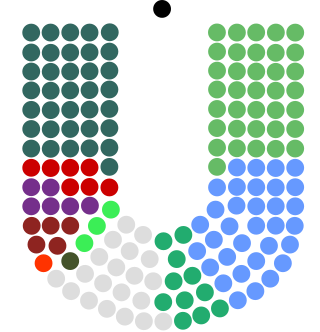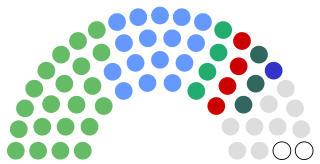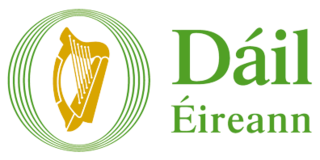
The Oireachtas, sometimes referred to as Oireachtas Éireann, is the bicameral parliament of Ireland. The Oireachtas consists of the president of Ireland and the two houses of the Oireachtas, a house of representatives called Dáil Éireann and a senate called Seanad Éireann.
There were two governments in the 18th Dáil, which was elected at the 1965 general election held on 7 April 1965. Both were single-party Fianna Fáil governments, which had been in government since the 1957 election. The 11th government of Ireland was led by Seán Lemass as Taoiseach and lasted for 569 days. The 12th government of Ireland was led by Jack Lynch as Taoiseach and lasted for 966 days.
There were two governments of the 16th Dáil, which was elected at the 1957 general election held on 5 March. The outgoing minority coalition government of Fine Gael, the Labour Party and Clann na Talmhan had failed to be returned. The 8th government of Ireland was led by Éamon de Valera as Taoiseach, until his election as president of Ireland at the 1959 election. It lasted for 820 days from its appointment until de Valera's resignation on 17 June 1959, and continued to carry out its duties for a further 6 days until the appointment of its successor, giving a total of 826. The 9th government of Ireland was led by Seán Lemass as Taoiseach and lasted for 873 days. Both were single-party Fianna Fáil governments.
The 7th executive council of the Irish Free State was the Executive Council formed after the general election to the 8th Dáil held on 24 January 1933. It was led by Fianna Fáil leader Éamon de Valera as President of the Executive Council, who had first taken office in the Irish Free State after the 1932 general election. It lasted for 1,625 days.
There were two governments of the 6th Dáil. The 4th executive council of the Irish Free State was formed after the September 1927 general election to the 6th Dáil held on 15 September 1927. The 4th executive council lasted for 900 days from its appointment until it resigned from office, and continued to carry out its duties until the appointment of its successor for a further 5 days, for a total of 905 days. The 5th executive council of the Irish Free State was formed after the executive council resigned in a Dáil defeat. It lasted for 708 days. Both minority governments of Cumann na nGaedheal led by W. T. Cosgrave as President of the Executive Council and had the same composition in personnel.

Seanad Éireann was the upper house of the Oireachtas (parliament) of the Irish Free State from 1922 to 1936. It has also been known simply as the Senate, First Seanad, Free State Senate or Free State Seanad. The Seanad was established under the 1922 Constitution of the Irish Free State. A number of constitutional amendments were made to change the manner of its election and its powers. It was eventually abolished in 1936 when it attempted to obstruct constitutional reforms favoured by the government. It sat, like its modern successor, in Leinster House.
The Fourth Amendment of the Constitution Act 1972 is an amendment to the Constitution of Ireland which lowered the voting age for all national elections and referendums in the state from twenty-one to eighteen years of age. It was approved by referendum on 7 December 1972 and signed into law on 5 January 1973.
The Seventh Amendment of the Constitution Act 1979 is an amendment to the Constitution of Ireland that provides that the procedure for the election of six members of the Senate in the university constituencies could be altered by law. It was approved by referendum on 5 July 1979 and signed into law on 3 August of the same year.
The Ninth Amendment of the Constitution Act 1984 is an amendment to the Constitution of Ireland that allowed for the extension of the right to vote in elections to Dáil Éireann to non-Irish citizens. It was approved by referendum on 14 June 1984, the same day as the European Parliament election, and signed into law on 2 August of the same year.
Amendments to the Constitution of Ireland are only possible by way of referendum. A proposal to amend the Constitution of Ireland must be initiated as a bill in Dáil Éireann, be passed by both Houses of the Oireachtas (parliament), then submitted to a referendum, and finally signed into law by the president of Ireland. Since the constitution entered into force on 29 December 1937, there have been 32 amendments to the constitution.
An ordinary referendum in Ireland is a referendum on a bill other than a bill to amend the Constitution. The Constitution prescribes the process in Articles 27 and 47. Whereas a constitutional referendum is mandatory for a constitutional amendment bill, an ordinary referendum occurs only if the bill "contains a proposal of such national importance that the will of the people thereon ought to be ascertained". This is decided at the discretion of the President, after a petition by Oireachtas members including a majority of Senators. No such petition has ever been presented, and thus no ordinary referendum has ever been held.
In Ireland, direct elections by universal suffrage are used for the President, the ceremonial head of state; for Dáil Éireann, the house of representatives of the Oireachtas or parliament; for the European Parliament; and for local government. All elections use proportional representation by means of the single transferable vote (PR-STV) in constituencies returning three or more members, except that the presidential election and by-elections use the single-winner analogue of STV, elsewhere called instant-runoff voting or the alternative vote. Members of Seanad Éireann, the second house of the Oireachtas, are partly nominated, partly indirectly elected, and partly elected by graduates of particular universities.

The Oireachtas of the Irish Free State was the legislature of the Irish Free State from 1922 until 1937. It was established by the 1922 Constitution of Ireland which was based from the Anglo-Irish Treaty. It was the first independent Irish Parliament officially recognised outside Ireland since the historic Parliament of Ireland which was abolished with the Acts of Union 1800.

The current Constitution of Ireland came into effect on 29 December 1937, repealing and replacing the Constitution of the Irish Free State, having been approved in a national plebiscite on 1 July 1937 with the support of 56.5% of voters in the then Irish Free State. The Constitution was closely associated with Éamon de Valera, the President of the Executive Council of the Irish Free State at the time of its approval.
The 16th Dáil was elected at the 1957 general election on 5 March 1957 and met on 20 March 1957. The members of Dáil Éireann, the house of representatives of the Oireachtas (legislature) of Ireland, are known as TDs. It sat with the 9th Seanad as the two Houses of the Oireachtas.
Two referendums, related to the Third and Fourth Amendment of the Constitution Bills, were held in Ireland on 16 October 1968, each on a proposed amendment of the Irish constitution relating to the electoral system. Both proposals were rejected.

Seanad Éireann is the senate of the Oireachtas, which also comprises the President of Ireland and Dáil Éireann.

Dáil Éireann is the lower house, and principal chamber, of the Oireachtas, which also includes the president of Ireland and a senate called Seanad Éireann. It consists of 160 members, each known as a Teachta Dála. TDs represent 39 constituencies and are directly elected for terms not exceeding five years, on the system of proportional representation by means of the single transferable vote (PR-STV). Its powers are similar to those of lower houses under many other bicameral parliamentary systems and it is by far the dominant branch of the Oireachtas. Subject to the limits imposed by the Constitution of Ireland, it has power to pass any law it wishes, and to nominate and remove the Taoiseach. Since 1922, it has met in Leinster House in Dublin.
The Constitution Act, 1936 was an act of the Oireachtas (parliament) of the Irish Free State which abolished Seanad Éireann, the upper house of the Oireachtas, which thenceforth was unicameral, with Dáil Éireann as the sole house. The bill was introduced in 1934 by the Fianna Fáil government of Éamon de Valera, which was frustrated by the Seanad's repeated use of its power to delay legislation. In particular, Fianna Fáil favoured eliminating symbols of monarchy from the Free State, which the Seanad, with more Southern Unionist members, feared would antagonise the United Kingdom.
The Constitution Act 1936 was an Act of the Oireachtas of the Irish Free State amending the Constitution of the Irish Free State which had been adopted in 1922. It abolished the two university constituencies in Dáil Éireann.





